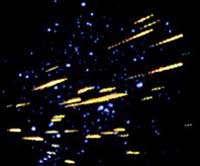|
|
|
Leonid Meteor Shower To Perform Late Tonight Washington DC (SPX) Nov 17, 2009  The annual Leonid meteor shower should be reaching its climax late tonight in the U.S., from about 1 a.m. your local time to dawn Tuesday morning November 17th. "Viewing conditions will be excellent, because the Moon won't be lighting the sky this year," says Alan MacRobert, senior editor of Sky and Telescope magazine. "You might see 20 or 30 meteors per hour under ideal dark-sky condition ... read more
The annual Leonid meteor shower should be reaching its climax late tonight in the U.S., from about 1 a.m. your local time to dawn Tuesday morning November 17th. "Viewing conditions will be excellent, because the Moon won't be lighting the sky this year," says Alan MacRobert, senior editor of Sky and Telescope magazine. "You might see 20 or 30 meteors per hour under ideal dark-sky condition ... read moreChandrayaan Instrument Finds Magnetosphere Around Moon  Bangalore, India (PTI) Nov 17, 2009
Bangalore, India (PTI) Nov 17, 2009After confirming the presence of water on the lunar surface, India's Chandrayaan-1 mission has, for the first time, discovered mini-magnetosphere that would throw light on the "inventory" of Hydrogen on the moon, a top space scientist said on Friday. SARA (Sub-keV Atom Reflecting Analyser), an instrument on board the country's first lunar orbiter, has made the discovery, Dr Anil Bhardwaj ... more
|
Vietnam says parched Red River at record low
China to be world's third biggest wind power producer: media Cost-cutting NASA eyes three cheap space missions Honduras declares state of emergency amid drought Russia in secret plan to save Earth from asteroid: official Sarkozy scrambles to salvage carbon tax French carbon tax ruled illegal Brazil's Lula signs law cutting CO2 emissions 2009 a 'benign' year of natural disasters: German re-insurer Greenpeace Spain demands Denmark release its director
| |||||||||||||||
| Previous Issues | Nov 16 | Nov 13 | Nov 12 | Nov 11 | Nov 10 |
| . |
NASA finds water on the moon Washington (AFP) Nov 14, 2009
Washington (AFP) Nov 14, 2009The dramatic revelation of a "significant amount" of frozen water found on the moon has been hailed by the jubilent US space agency as heralding a giant leap forward in space exploration. "The discovery opens a new chapter in our understanding of the moon," NASA said after the startling find was announced Friday, as ecstatic scientists celebrated the landmark revelation. Preliminary data ... more Ghostly 'Spokes' Puff Out From Saturn's Ring's  Pasadena CA (SPX) Nov 17, 2009
Pasadena CA (SPX) Nov 17, 2009Massive, bright clouds of tiny ice particles hover above the darkened rings of Saturn in an image captured by the Cassini spacecraft on Sept. 22, 2009, around the time of Saturn's equinox. During this period, sunlight hits the rings edge-on and shines directly over the equator. The levitating icy particle clouds, which are known as "spokes" and are as wide as 10,000 kilometers ... more Moon holds key to solar system's secrets  Washington (AFP) Nov 13, 2009
Washington (AFP) Nov 13, 2009The moon, which is once again the focus of an international space race, could hold the key to the birth of our planet some 4.5 billion years ago, and help unlock the oldest secrets of the universe. Forty years after American Neil Armstrong first walked on the moon, and as the United States aims to return astronauts to Earth's nearest neighbor by 2020, it remains an object of fascination and ... more |
. |
| . |
Radiation: The Moon's Greatest Menace Sydney, Australia (SPX) Nov 12, 2009
Sydney, Australia (SPX) Nov 12, 2009The Moon is a harsh place, as decades of direct exploration have demonstrated. It carries all of the risks of conventional spaceflight, then adds to them. The tyranny of distance from Earth makes emergency returns difficult. The dust on the surface could be dangerous to inhale. Meteorites pepper the surface. These are serious problems, but the greatest threat to future human explorers will ... more Rapid Star Formation Spotted In 'Stellar Nurseries' Of Infant Galaxies  Durham, UK (SPX) Nov 12, 2009
Durham, UK (SPX) Nov 12, 2009The Universe's infant galaxies enjoyed rapid growth spurts forming stars like our sun at a rate of up to 50 stars a year, according to scientists at Durham University. The findings show that "stellar nurseries" within the first galaxies gave birth to stars at a much more rapid rate than previously expected, the researchers from Durham's Institute for Computational Cosmology revealed. ... more A Bubbling Ball Of Gas  Bonn, Germany (SPX) Nov 12, 2009
Bonn, Germany (SPX) Nov 12, 2009The Sun is a bubbling mass. Packages of gas rise and sink, lending the sun its grainy surface structure, its granulation. Dark spots appear and disappear, clouds of matter dart up - and behind the whole thing are the magnetic fields, the engines of it all. The SUNRISE balloon-borne telescope, a collaborative project between the Max Planck Institute for Solar System Research in Katlenburg ... more |
. |
| Previous Issues | Nov 16 | Nov 13 | Nov 12 | Nov 11 | Nov 10 |
| The contents herein, unless otherwise known to be public domain, are Copyright 1995-2009 - SpaceDaily. AFP and UPI Wire Stories are copyright Agence France-Presse and United Press International. ESA Portal Reports are copyright European Space Agency. All NASA sourced material is public domain. Additional copyrights may apply in whole or part to other bona fide parties. Advertising does not imply endorsement, agreement or approval of any opinions, statements or information provided by SpaceDaily on any web page published or hosted by SpaceDaily. Privacy statement |